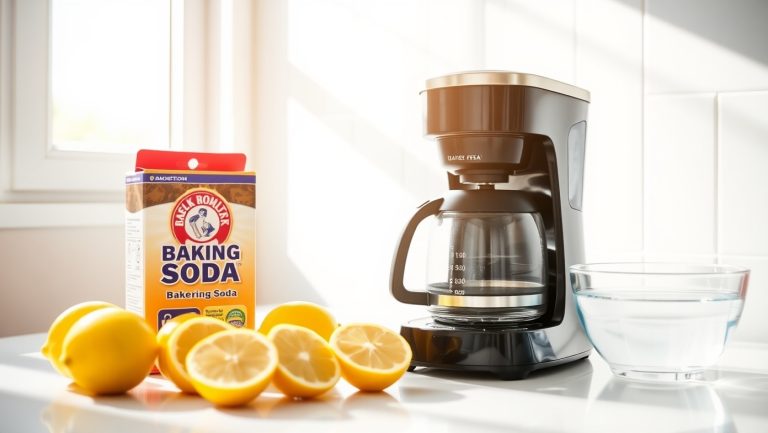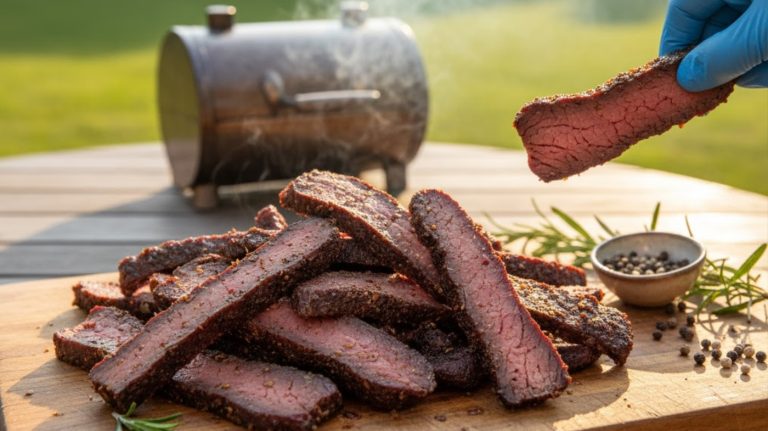Chipotle Chile Pepper vs Chili Powder: Key Differences
You’ll find chipotle chile pepper offers smoky, earthy heat from smoked dried jalapeños, while chili powder blends ground chilies with spices like cumin and garlic for layered warmth without smokiness.
Chipotle’s smoky intensity suits BBQ and sauces, whereas chili powder shines in Tex-Mex and chili dishes. They’re not directly interchangeable; adjust quantities and spices if substituting.
Both impact flavor complexity and heat differently—understanding these contrasts will elevate how you use each in cooking.
Key Takeaways
- Chipotle peppers are smoked, dried jalapeños with a smoky flavor, while chili powder is a spice blend including ground chili peppers and other seasonings.
- Chipotle powder delivers smoky, earthy heat; chili powder offers a warmer, herbaceous spice without smokiness.
- Chipotles are ideal for BBQ, marinades, and smoky dishes; chili powder suits Tex-Mex, chili con carne, and layered spice profiles.
- Both are low-calorie and gluten-free; chipotle provides trace vitamins, while chili powder’s nutrients depend on its spice blend.
- Substitute chipotle powder for chili powder at reduced amounts, adding cumin and oregano; replace chipotle with chili powder plus smoked paprika.
A Side-by-Side Flavor Comparison
| Feature | Chipotle Chile Pepper | Chili Powder |
|---|---|---|
| Base Ingredient | Smoked, dried jalapeños | Blend of ground chilies and spices |
| Flavor Profile | Smoky, earthy, slightly sweet | Warm, herbaceous, mildly spicy |
| Heat Level | Moderate (2,500–10,000 SHU) | Mild to moderate, varies by blend |
| Uses | BBQ, marinades, sauces, smoky stews | Tex-Mex, chili con carne, spice rubs |
| Form | Pure pepper (whole or ground) | Pre-mixed seasoning blend |
| Substitution Tips | Use less and add cumin, oregano when replacing chili powder | Add smoked paprika to mimic chipotle flavor |
| Availability | Less common, found in specialty stores | Widely available in supermarkets |
| Nutritional Note | Contains antioxidants, vitamin A, smoky polyphenols | Nutrients vary based on blend; may include salt or MSG |
Definition and Composition of Chipotle Chile Pepper and Chili Powder
Understanding the definition and composition of chipotle chile pepper and chili powder is essential for distinguishing their culinary roles and flavor profiles.
You’ll find that chipotle peppers are smoked, dried ripe red jalapeños, processed to develop a smoky-sweet profile with capsaicin levels typically between 2,500 and 10,000 SHU. They come as whole pods or in adobo sauce, containing no added spices in pure form.
Chipotle peppers are available in two main varieties: ahumado (larger brown) and morita (smaller deep crimson), each offering a slightly different smoky flavor varieties of chipotle.
Conversely, chili powder refers to a seasoning blend combining ground chili peppers—often cayenne or mixed varieties—with spices like cumin, garlic powder, and oregano. This blend dilutes the chili’s heat and introduces pungent, herbal notes, resulting in a more complex but less smoky flavor.
Chipotle powder, a variant made solely from smoked jalapeños, contrasts with chili powder’s multi-ingredient composition and diverse heat levels.
Distinct Flavor Profiles Explained
You’ll notice chipotle peppers deliver a pronounced smoky note layered with earthy undertones, creating a complex flavor profile. This arises because chipotle peppers are smoked and dried jalapenos, a traditional preservation method originating in Mexico.
In contrast, chili powder combines various spices, offering a multifaceted but less singularly smoky character. Understanding these differences helps you select the right ingredient to achieve your desired taste complexity.
Smoky vs Earthy Notes
The contrast between smoky and earthy notes defines the distinct flavor profiles of chipotle peppers and chili powder.
Chipotles, smoked dried jalapeños, deliver a dominant smoky flavor from wood smoking, adding depth and a subtle bitterness that balances sweetness. The smoking process not only imparts flavor but also reduces moisture, concentrating the pepper’s heat and resulting in a more intense spice profile smoke-drying method.
Chili powder, lacking this smoking process, emphasizes earthy, raw pepper tones without smoky complexity.
Consider these differences:
- Smoke Intensity: Chipotles offer deep, barbecue-like smokiness; chili powders don’t.
- Earthiness Depth: Chipotle’s earthiness is robust and savory, grounding the smoke; chili powder’s earthiness is milder, often grassy or woodsy.
- Flavor Balance: Chipotle’s smoky and earthy layers moderate heat and add complexity; chili powder presents straightforward, raw pepper warmth.
Spice Blend Complexity
While both chipotle powder and chili powder share a chili pepper base, their flavor complexities diverge sharply due to differences in composition and processing.
Chili powder is a composite blend, combining ground dried chiles with garlic, cumin, Mexican oregano, paprika, and occasionally onion powder or sugar, producing a layered, earthy, and slightly sweet profile.
This multi-component structure introduces herbal bitterness and savory pungency absent in chipotle powder. In addition to its flavor, chili powder also provides various health benefits such as vitamins, antioxidants, and capsaicin.
Conversely, chipotle powder consists solely of smoked, dried ripe jalapeños, emphasizing a smoky, slightly sweet heat derived from the smoking process and higher capsaicin content. Its singular ingredient focus yields a purer, more intense pepper flavor without added spices.
Common Culinary Uses and Recipe Applications
When you’re working with BBQ and marinades, chipotle peppers deliver a distinct smoky heat that enhances depth, while chili powder provides a milder, more versatile spice base.
Chipotle peppers are often canned in adobo sauce, which includes herbs and spices that contribute to their unique flavor profile. In Tex-Mex and chili recipes, chili powder acts as a foundational seasoning, balancing heat and flavor complexity.
BBQ and Marinades
Because chipotle powder comes from smoked jalapeños, it injects a distinct smoky heat into BBQ rubs and marinades that chili powder’s multi-spice blend can’t fully replicate. Chipotle powder is made from smoked, dried jalapeños, which gives it that unique flavor profile.
When you’re crafting BBQ dishes, consider these key distinctions:
- Flavor Impact: Chipotle powder imparts a consistent smoky heat, ideal for smoked ribs or brisket rubs, while chili powder offers a milder, layered spice with cumin and oregano notes.
- Heat Control: Chipotle powder delivers predictable moderate heat, enhancing perceived intensity through smokiness; chili powder’s heat varies by pepper types.
- Application Synergy: Use chipotle powder for depth without extra smoking; combine both powders to balance smokiness and complex spicing in composite marinades.
Tex-Mex and Chili
Although chipotle and chili powders both play integral roles in Tex-Mex cuisine, their culinary applications diverge considerably due to their distinct compositions and flavor profiles.
You’ll find chipotle powder, derived from smoked, dried jalapeños, used in salsas, taco seasonings, and chili con carne to impart smoky heat and depth. It excels in recipes demanding focused smokiness, such as smoked meat tacos or chipotle-laced sauces.
Additionally, chipotle powder is a type of single spice chile powder, which means it contributes a specific flavor profile without additional seasoning complexity.
In contrast, chili powder is a multi-spice blend including cumin, oregano, and garlic powder, offering balanced heat and herbal complexity without smokiness. You often use it in traditional chili con carne and Tex-Mex stews for layered seasoning.
Flavor Enhancement Roles
Since chipotle chile peppers and chili powder each offer distinct flavor profiles, understanding their roles in flavor enhancement is essential for precise culinary application.
Chipotle peppers impart a smoky, slightly sweet heat, ideal for deepening savory dishes, while chili powder delivers a complex, earthy spice blend with variable heat levels.
Consider these functional uses:
- Chipotle peppers excel in sauces, stews, and marinades requiring smoky depth, such as adobo or chipotle chili.
- Chili powder suits spice rubs, chili con carne, and soups, providing layered heat and aromatic complexity.
- Both add warmth, but chipotle emphasizes smokiness; chili powder enhances mixed spice notes, allowing tailored flavor profiles in recipes. For example, chipotle powder’s inclusion in recipes like chipotle chili highlights its smoky and spicy elements.
Variability in Spice Blends and Origins
When exploring chile and chili powders, you’ll find considerable variability in their blends and origins, which directly impacts their flavor and culinary uses.
Chile powder consists purely of ground dried chile peppers, while chili powder is a blend that typically includes cumin, oregano, garlic powder, and sometimes unexpected ingredients like cinnamon.
Chile powder is just ground dried peppers; chili powder combines peppers with spices like cumin and oregano.
The pepper variety—such as jalapeño for chipotle or cayenne for cayenne powder—defines heat and flavor profiles.
Processing methods also differ; chipotle powder’s smoky character arises from smoking jalapeños before drying, unlike most chili powders. Chipotle chiles are often available in forms such as whole dried chiles or ground into chipotle powder, providing versatility in cooking forms available.
Additionally, variations in drying, roasting spices, and grind fineness affect potency and texture. This diversity means you must carefully select powders based on intended flavor and heat, as substituting one for another can considerably alter your dish’s profile.
Nutritional and Dietary Considerations
Understanding the compositional differences between chipotle chile pepper and chili powder extends beyond flavor and heat profiles to their nutritional impacts.
Both spices are virtually calorie-free and contribute negligible macronutrients, making them insignificant sources of fat, protein, or carbohydrates in your diet.
According to the nutrition facts provided by McCormick, these spices have a serving size that allows consumers to gauge their daily dietary contributions effectively.
However, their micronutrient profiles and dietary considerations differ subtly:
- Chipotle chile pepper provides trace amounts of vitamins A, C, and potassium, whereas chili powder blends may contain additional micronutrients depending on added spices.
- Both are gluten-free in pure form, but chili powder blends can contain allergens or additives like MSG and salt, affecting special diets.
- Capsaicin in both spices may enhance metabolism and digestion but can cause gastrointestinal irritation in sensitive individuals.
How to Substitute Between Chipotle Powder and Chili Powder?
Although chipotle powder and chili powder both originate from chili peppers, their distinct flavor compositions and heat intensities require careful adjustment when substituting one for the other in recipes.
When replacing chili powder with chipotle powder, reduce the quantity to half or two-thirds to prevent excessive smokiness and heat. Since chili powder contains complementary spices like cumin, oregano, and garlic powder, you should add these when using chipotle powder alone to approximate its complexity.
Chipotle powder is made from finely ground chipotle peppers, derived from jalapeños, which gives it a characteristic smoky flavor.
Conversely, substituting chili powder for chipotle powder diminishes smokiness and pepper intensity; supplement with smoked paprika or a bit of chipotle powder for authenticity.
Taste testing is critical during substitution, as heat and flavor profiles vary widely. Adjust liquid and seasoning levels accordingly to maintain balance in your dish.
Availability and Sourcing Tips
Because chipotle chile peppers undergo a specialized smoking and drying process, their availability is more limited compared to chili powder, which you can find widely in supermarkets.
Chipotle peppers, smoked and dried, are less commonly found than widely available chili powder.
Chipotles are primarily sourced from Mexico, sold as whole dried pods or ground powder, often through specialty stores and online platforms. Chili powder, generally a blend, is broadly distributed and available in various quality grades.
For sourcing:
- Select whole chipotles with rich mahogany color to guarantee freshness; avoid faded or brittle specimens.
- Check chili powder labels to distinguish pure chile powder from seasoning blends with fillers like garlic or starch.
- Prefer reputable brands offering organic or authentic varietals, such as Morita chipotles or ancho-based chili powders, for consistent flavor and quality.
Additionally, chipotles can be found canned in adobo sauce, which provides a smoky flavor with less intense heat than the dried peppers alone.
Enhancing Dishes With Smoky vs Savory Heat
When you choose between chipotle powder and chili powder, you’re selecting not just heat but distinct flavor dimensions that influence a dish’s character.
Chipotle powder delivers moderate heat with smoky undertones, enhancing grilled meats, stews, and sauces by adding wood-fired aroma and a dark reddish-brown hue. It intensifies richness and creates bold, smoky depth. Since chipotle powder consists solely of dried, smoked jalapeño peppers, it maintains a distinct smoky jalapeño flavor.
Conversely, chili powder provides a milder, earthy heat with complex savory notes from cumin, oregano, and garlic. This blend suits recipes needing layered seasoning, such as chili con carne and Tex-Mex dishes, contributing aromatic complexity without smokiness.
Substituting one for the other shifts heat perception and flavor profiles markedly—chipotle powder emphasizes smoky heat, while chili powder offers spiced warmth and herbal nuances, allowing precise culinary control over a dish’s sensory impact.
Frequently Asked Questions
Can Chipotle Powder Be Used in Sweet Dishes?
Yes, you can use chipotle powder in sweet dishes to add smoky, mildly spicy complexity.
When you incorporate it in small amounts, it enhances flavors like chocolate, vanilla, and caramel without overpowering sweetness.
You should balance chipotle’s heat with sugars or creamy elements to maintain harmony.
Using it with complementary spices or fruit extracts will give your desserts depth and a unique sweet-spicy contrast, ideal for creative culinary applications.
Does Chili Powder Lose Flavor Over Time Faster Than Chipotle Powder?
Think of flavor as a flickering flame—chili powder’s flame dims quicker than chipotle’s steady glow.
You’ll find chili powder, a complex blend, loses its potency within 6 to 12 months due to varying spice degradation rates.
In contrast, chipotle powder, made from smoked jalapeños, retains its smoky heat up to 2 years thanks to reduced moisture and stable compounds.
Storing both airtight slows decay, but chipotle’s flavor is inherently more resilient.
Are There Health Benefits Unique to Smoked Chipotle Peppers?
You’ll find smoked chipotle peppers uniquely rich in antioxidants, thanks to the smoking process boosting total phenols by nearly 50% and enhancing flavonoids and catechins.
While capsaicin slightly decreases, it remains sufficient to support metabolic and anti-inflammatory benefits.
Smoking also creates distinctive polyphenolic profiles and smoky flavor compounds, offering cardiovascular advantages like reduced cholesterol and blood pressure.
These combined effects make smoked chipotle nutritionally superior with specific health benefits.
How Does Storage Affect the Smokiness of Chipotle Powder?
Think of chipotle powder like a delicate flame—exposure to air, moisture, heat, and light quickly dims its smokiness.
You’ll want to store it in airtight, opaque containers away from sunlight and heat to preserve volatile aromatic oils. Even then, smokiness fades gradually over time.
Refrigeration or freezing can extend potency for up to two years, but regular sealing and minimal container opening are essential to maintaining that signature smoky flavor.
Can Children Safely Consume Chipotle Powder in Meals?
You should be cautious when giving children chipotle powder, as its capsaicin content can irritate sensitive mucous membranes and cause nausea or vomiting.
Children have lower tolerance to spicy compounds, risking mucosal irritation and increased blood pressure.
It’s safer to avoid pure chipotle powder in kids’ meals or use heavily diluted amounts.
Always monitor for adverse reactions, and consider milder spices to introduce heat gradually while minimizing health risks.
Final Notes on Flavor: Choose the Right Spice Every Time
When choosing between chipotle chile pepper and chili powder, think of them like two distinct instruments in your culinary orchestra—each delivers unique tones of smoky heat or complex savory warmth.
You’ll want to match your selection precisely to your recipe’s flavor profile and desired intensity. Understanding their composition, uses, and substitutions sharpens your ability to enhance dishes with targeted spice nuances, ensuring balanced, intentional seasoning rather than a one-size-fits-all approach.







